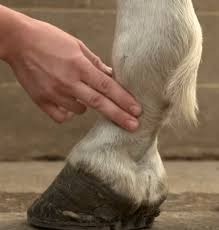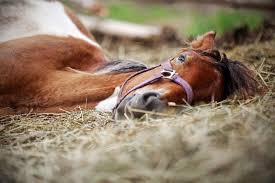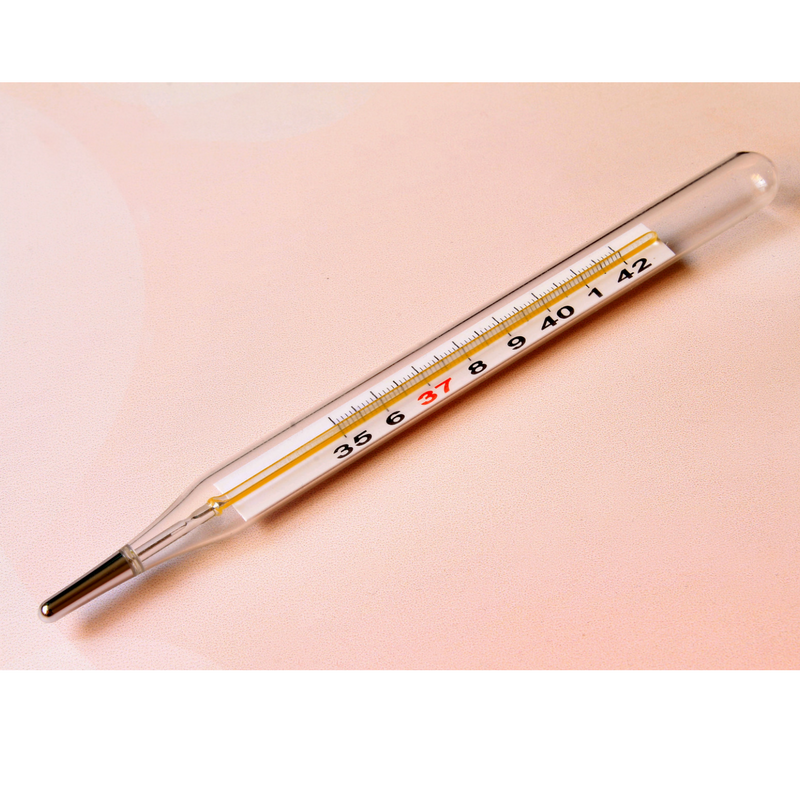Whacky Adventures of the Clutzy Horse
Do you have a horse that is constantly getting injured?
Have you ever had that horse that seems to always get some form of injury FOR NO APPARENT REASON AT ALL?
Imagine my angst to start 2019 with exactly that - a horse, previously without concerns, suddenly getting into all sorts of mischief!
It all started with his very first hoof abscess (that we know of, anyway).
He ate his morning feed perfectly fine, and had a very minor tenderness to the way he walked out into the paddock - a walk that looked much more like a hesitation for extra treats than any actual pain. One and a half hours later, as I collect him from the paddock for our weekly riding lesson, you think his hoof would have fallen off by the limp! (Cue for all horse owners to go -yep, tell tale abscess there!).
Poor blighter had never been with us for any kind of injury and turns out his is the biggest sook! Turns out, I’m also a big softy. Custard received the biggest spoiling and extra treats & hay (good tip to improve your bond through a crisis is to take the chance to emotionally support their needs as well as medically support them!).
Abscess passed as they do, and it is now 2 weeks later and time for our next lesson. Would you believe me if I were to tell you that the exact same thing happened again? Ate breakfast, left fine, collect from the paddock with a massive limp, got lots of spoiling, treats and hay.
It’s at this point I’m wondering if I am just that unlucky or am being outsmarted by a cunning ploy cooked up in the paddock for extra treats. I’ll let you decide.
Abscess passed yet again. A certain Custard is looking very impressed with himself. That is, until he comes in one Saturday morning (yes, just before our lesson) with a piece of stick jammed almost 3cm into his knee!
Obviously, all that money saved from the lack of lessons went straight into an emergency veterinary bill. Flushing, stitching, antibiotics, pain relief, and a massive restocking of the first aid kit due to all the bandaging in the first week!
The ultimate first aid kit checklist for your horse
Click here to accessBright side is that the stick didn’t actually penetrate the joint capsule. Not sure what stroke of luck that was but I’ll take it!
Thankfully, one month later Custard is well on his way to recovery although still can’t be ridden. And I’m still trying to figure out if I’m just mildly unlucky or if Custard has outsmarted me.
You decide! Comment below if you think Sarah is being conned by her pony, or tell us about your own clutzy horse stories!
First Aid for Horses: The Heart
Do you know your horses heart rate?
Do you know your horses average heart rate?
I bet you don’t.
Yet it’s one of the most important baseline readings to evaluate illness, pain, stress and overexertion in your horse.
About the heart rate
Taking the pulse rate via the maxillary artery under the jaw.
A normal resting heart rate for a horse is between 28-45 beats per minute, however this is not true for every horse. Some may have a heart beat much lower, as low as 24, and some may reach as high as 50. Each 'lub-dub' counts as 1 single full heart beat.
Anxiety, pain and exercise can also increase a horse’s heart rate to as much as 200 beats per minute.
It is a good idea to have a fair understanding of what is normal for your horse, so you can identify when they are unwell. A baseline should be done over several days, during different times of the day, and after different levels of activity, to give you the best understanding of what is normal for your horse.
How to take a heart rate for a horse
To assess the heart or pulse rate, you will need a timer (watch or phone) to monitor as you count the beats. It is easiest to do the counting for 15 or 30 seconds, then times the result by 4 or 2 respectively.
There are also some great pet apps that you can download for heart or respiration rates that make the job significantly easier, and quite a few of them are free! I personally like Cardalis, which is a free app for tracking respiration rate in dogs, but works just as well for respiration and pulse rates in other animals too; but there are plenty out there, just use one that works best for you.
Locations for Taking the Heart or Pulse Rate
Taking the digital pulse rate
There are 4 ways to take the heart or pulse rate of your horse:
Use a stethoscope to listen to the heart. Place the stethoscope on the left side of the chest just under and behind the elbow.
Take the pulse rate via the Maxillary artery (under the jaw). Cup your hand on the left side of the jaw with 2 fingers under the inside of the cheek. Feel along until you left side of the jaw with 2 fingers under the inside of the cheek. Feel along until you can feel a consistent beat.
Take the pulse rate via the Digital artery (near the fetlock). The groove just above and below the outside of the fetlock is the best place to locate the digital pulse. Due to the location, it can be difficult to hold the pulse and count for the allotted time, so the digital pulse is more often used to indicate if there is a problem with the leg or foot.
Take the pulse rate via the Radial artery (inside the front knee). This is the equivalent of the wrist in people, but can be very difficult to find in some horses. Place your fingers on the inside of the knee about 3/4 of the way around to the back.
What is abnormal?
This can vary, but here are a few times I would look for further help:
The heart rate is consistently significantly higher than normal without any reason (i.e. no workout or stress factors applied). For example, if your horse’s normal heart rate is 30 beats per minute and has been sitting higher at 75 beats per minute for over half an hour, I would be suspicious.
The respiration rate is also high, or the breathing exaggerated, without exertion or stress.
There are signs of pain such as lameness, or colic symptoms.
Listening the heart through the stethoscope is muffled, or sounds a bit like a washing machine, or has a gallop rhythm (this is hard to explain without having heard one before, so if your vet ever mentions it, ask the to listen as well).
You cannot find a digital pulse and you suspect injury to the leg
You feel heat around the fetlock and the digital pulse seems to be quite ‘thumpy’
There is suspected blood loss, the pulse is weak and gums are pale.
As always, if you have concerns, seek professional assistance. But understanding what is normal and therefore abnormal for your horse may lead to faster treatment, which may save your horses life.
First Aid for Horses: Shock
Do you know the signs of shock?
Have you ever seen a horse in shock?
I have.
You may have as well, but didn’t realise what you were looking at.
Shock in horses is very much like it is for humans. It is the bodies way of coping with imminent death, where we end up with a sudden decrease in both blood circulation and blood pressure.
Shock, untreated, can kill.
It can be very subtle or extremely obvious when a horse goes into shock.
What causes shock?
Shock can occur for several reasons:
Blood loss
Severe pain, such as colic or an injury
Septic shock from an infection turned toxic
Dehydration
Severe allergic reaction
Extreme response to fear or emotional trauma
What are the symptoms of shock?
Healthy, pink gums. Horses in shock will usually have a white or grey appearance in their gums, with the exception of septic shock.
A horse that is in shock may display several of these symptoms
Pale mucus membranes (such as the gums, nostrils and eyelids), leaning towards white or grey in colour as opposed to a healthy pink. Septic shock can show up as bright red gums, or with a purple tinge to the gums near the teeth.
Slow capillary refill time. To test this, hold your thumb or finger on the gum and press for a few seconds. This should leave a white mark. Then count how long it takes for the colour to return to normal. Healthy capillary refill time is under 2 seconds.
Depression
Shivering, cool to touch
Rapid weak pulse (particularly if it’s over 80 beats per minute)
Rapid breathing that is shallow
Profuse sweating
Anxiety or confusion
Temperature may be low (but not always)
The horse may lie down
What to do if I suspect my horse is in shock?
This, and I cannot stress this enough, is a serious emergency. It is time to get your vet to your horse NOW– not in 5 minutes, not in an hour.
Identify if there are any suspicious signs, such as an injury, or bleeding, and ask the vet what you can do. The more information you can provide your vet, the more likely they are to triage your emergency as the highest priority and bust a tail to get to your paddock.
There is little else you can do until the vet arrives. If your horse is cold or shivering, you may cover the horse with a blanket to try to keep their temperature regulated, but be aware they can just as quickly overheat in this situation. Stay with your horse and continue to monitor the situation, keeping them as calm as possible. If you can, relocate them to a safe location such as a barn or feeding yards, and place a halter on them. You may be able to offer them some water.
Once your vet arrives, they will assess and advise you of the best course of action. Depending on the likely cause of the problem, they may suggest anything from intravenous fluids (a drip), electrolyte injections, or other medications, as well as stemming any major haemorrhage if blood loss is the cause of shock. Their primary goal is to first stabilise the shock, then act on treatment accordingly.
Remember, shock can kill. Understand the signs and you could save your horses life.
First Aid for Horses – Colic
Colic is a word that strikes fear and dread into the heart of many horse owners. Forewarned is forearmed!
Colic is a scary thought for most horse owners, which conjures up images of long nights in the paddock with the horse and large veterinary bills. Let’s delve deeper and define this concerning problem.
Enteroliths from a horse, a cause of colic.
Colic, by definition, is any abdominal condition that causes pain, so in reality is a symptom of a problem, not the actual disease itself. Colic for some horses can be life threatening, and yet for others may be chronic and create discomfort for a long period of time. Colic may require surgical or medical intervention, or may be able to treated with diet or home remedies, but it can be difficult to determine the cause without medical attention and therefore is something we should be consulting our veterinarian about. Colic is widely considered to be the leading cause of premature death in horses.
What are the causes of colic?
There are a number of different causes of colic, which can make management of this issue complex.
Timpanic colic - also known as gas or spasmodic colic, is often caused by a change in diet, although parasites may also be a factor. The build up of gas may be due to excess fermentation or the slowing of the passage of the gas. While gas colic may self-resolve, it can lead to torsion or displacement, which can be life-threatening.
Torsion and volvulus – this is where the intestine twists upon itself, and may obstruct the blood supply to areas of the GI tract. Prognosis is not great for many of these horses and early intervention is a must if they are to survive.
Displacement – this happens when a portion of the large intestine shifts. It can be a result of excess gas. The relocation may disrupt the standard motility or movement of the gut, and therefore create other issues as well. Medical or surgical intervention may be required.
Intasusseption - a form of colic in which a piece of intestine "telescopes" within a portion of itself, usually because a section of the bowel has become paralysed. It is kind of like a snake eating its tail. This is a life-threatening cause of colic that will require urgent surgical intervention.
Impaction – impaction is where a large clump of food or grit (like sand) form a clump in the bowel and create a blockage. It may resolve with medical intervention although occasionally surgery is required. Impaction most commonly occurs in winter, when there is less water intake and an increase in drier food supplied (i.e. hay), in horses with dental issues (poor mastication) or in horses kept on sandy or high dirt-to-grass pasture.
Parasites – heavy worm burdens may cause temporary blockages. It is important to carefully de-worm theses horses as they can have a serious immune reaction that can result in fatal peritonitis.
Other causes of colic – Tumors, Toxins, Colitis, Gastric Ulceration, Hernias, Enteroliths (mineral stones of the gut)
Dog sitting, a potential sign of colic
How can I tell if my horse has colic?
Early symptoms of colic
- Turning the head toward the flank
- Biting or kicking at the flank or abdomen
- Pawing at the ground
- Restlessness
- Depression
- Repeatedly lying down and getting up, or attempting to lie down
- Decrease or lack of appetite
- No or decreased bowel movements (note, passing manure is not a sign they do not have colic, as colic based in the upper GI tract will still pass manure for a while)
- Stretching out as if to urinate, but not urinating
- Decrease in abdominal sounds, or even no abdominal sounds
As the colic symptoms worsen and the horse is in more pain, you may see
- Sweating
- Rapid respiration
- Elevated pulse rate
- Rolling
flank biting, another sign of colic
What to do if my horse has colic?
- The very first thing to do is get in contact with your veterinarian. Colic can begin mildly but advance very quickly into a life-threatening condition. Be sure to describe the symptoms you are seeing and ask if your vet believes gentle exercise will help.
- Try to keep your horse from rolling. Rolling may twist the bowel and complicate the issue (however – safety first: a wildly thrashing horse may kill you). However, if you horse is just wanting to rest, it may be ok for him to lie down (check with your vet).
- Avoid feeding your horse hay or hard feed while you wait for the vet to attend.
- DO NOT administer any pain relief before your vet has examined your horse. This can mask the symptoms and lead to a misdiagnosis, and possibly the death of your horse.
How can I prevent colic?
There is no proven ways to prevent colic in horses, but some ways to help reduce the chances of your horse developing colic include:
- Introducing new feed gradually
- Avoid excess high sugar feeds
- Keep access to plenty of clean water
- Maintain a schedule of consistency
- If living in a sandy paddock, add psyllium husk to the feed, or avoid sandy paddocks altogether
- Ensure proper parasite control is maintained
Colic is a disease that is feared by horse owners, but with early, correct intervention many horses will recover. Get familiar with the symptoms, be proactive in intervention, and keep doing everything in your power to help reduce the risk of your horse experiencing this pain.
First Aid for Horses: Respiration Rate & Breathing
What can your horses breathing tell you about their health?
How many breaths your horse takes in a minute can be an important indicator of many conditions, including pain, heart or lung issues.
So what exactly is normal?
Healthy respiration rate for most horses is generally between 8 and 15 breaths per
minute, although it is higher in foals and can be significantly higher just after exercise.
A very relaxed horse can have a rate as low as 4 breaths per minute - that is usually a VERY relaxed horse.
The breathing itself should be calm and unexaggerrated, with relatively even spaces between each inhalation.
What is abnormal breathing?
- Breathing rate over 15 breaths per minute at rest
- Deep movement in the chest at rest- where the chest and/or abdomen have large, exaggerated movement - may indicate serious issues
- Noisy inhalation may indicate a problem, particularly with the upper respiratory tract
- Wheezing or coughing during exercise may also indicate some issues.
How to take a respiratory rate
- Allow the horse to settle and relax.
- Count the number of breaths for 30 seconds.
- Multiply that number by 2 - wallah!
There are some really great apps available for free that can help you easily monitor, count and record the respiratory rate - just search your relevant app store.
If you notice abnormalities, contact you veterinarian for advise.
First Aid for Horses: A Dose of Medicine
Dread the thought of medicating your horse? We have collated some tricks to make the chore easier!
Sooner or later, you are unfortunately going to have a situation where your horse is required to take medicine. For some horses, this is as simple as adding to their food. For others, it's a nightmare.
How can we get a horse to take medicine? We've collated a few tricks to help you succeed!
1. Mix with their regular feed
Sometimes, changes to the usual routine can make horses suspicious and less likely to cooperate. Try adding the medication to their normal feed and see how they respond. It may be worth introducing the medication at a lower dose initially to get them used to the subtle differences
It can also help to add some water to the feed to hide the powder.
2. Bran mash or molasses
Bran mash or molasses can be a great treat for some horses. Before you know it - medications are gone!
3. Apple sauce
Again, another sweet treat! You can make powder or pastes into an apple sauce slurry and place it in their feed bowl. Alternatively, if you have a wide tipped syringe, dose it like a wormer. If apple sauce isn't up your horses alley, you can try strained carrots or pears - these jars of baby food are an ideal single dose size!
4. Sandwich
Powders, smaller pellets and pastes can all be put between a folded piece of bread for a quickly gobbled dose. For powders and pellets, put something sticky on the bread, like molasses, jam or peanut butter. Remember, these are just treats to hide med's, so don't go overboard!
5. Hollow Apple
Try partially coring an apple, making sure not to go all the way through. Add the medication, then use part of the core to 'cork' it. This works really well if you use smaller apples and your horse is happy to take big bites (preferably the full apple).
6. When all else fails, ask your vet for an injection
Some medications are available in an injection - and your vet may be able to provide the injections or dose your horse regularly themselves.
HOT TIP:
If you use some of the treats, like apple sauce syringes or jam sandwiches, regularly or semi-regularly without medication, your horse will be much more willing to gobble it down when it comes to medication time!
What tricks do you use to get your horse to take their medicine?
First Aid for Horses: Temperature
Learning how to accurately take your horses temperature is an important first aid skill for horse owners.
A normal rectal temperature for a horse is 37.2-38.3°C
Learning how to take your horses temperature is an important skill for horse owners.
An unhealthy temperature can indicate the horse has an infection or disease, and is a good indicator for monitoring the progress of the problem.
Our first aid kit should contain:
- 1 or more thermometers, either digital or mercury
- 1 form of lubricant, such as Vaseline or KY Jelly
- A form of cleanser to sterilise and clean pre and post use (rubbing alcohol or chlorhexidine)
- Gloves
The procedure:
- Ensure your horse is safely restrained and calm.
- Cleans the thermometer and apply lubrication to the tip.
- Gently move to the back of the horse.
- Using one hand, lift the tail slightly to one side.
- Using the other hand, insert the thermometer into the rectum NO FURTHER THAN HALFWAY UP THE THERMOMETER ARM, using a gentle twisting motion.
- Angle the thermometer slightly so the inserted tip is angled upwards.
- Start the thermometer reading until beeps, or for 3 minutes if a mercury thermometer.
- Once finished, gently remove the thermometer from the rectum and read.
Tips:
- Always stand to the side of your horse to avoid being kicked.
- It is best to take your horses temperature after they have evacuated their bowels - faeces in the rectum can give you a falsely high reading.
- Have a piece of string tied to the thermometer and maintain hold of the thermometer when in use. Yes, horses can 'suck in' the thermometer and no, it has never happened to me. If it does happen, contact your veterinarian for advice.
- If you receive an abnormal temperature reading, repeat again and again in an hour. If the temperature stays consistently high, especially over 38.7°C, consult your veterinarian for advice.
Looking for more specific content?
Have a question you are seeking answers to? Send us a message and we will create a blog!
























